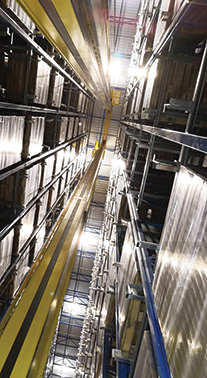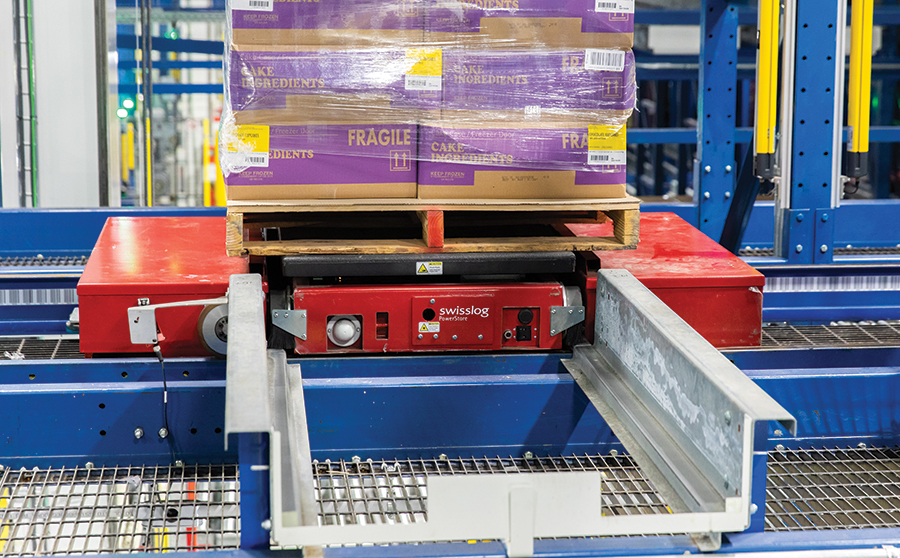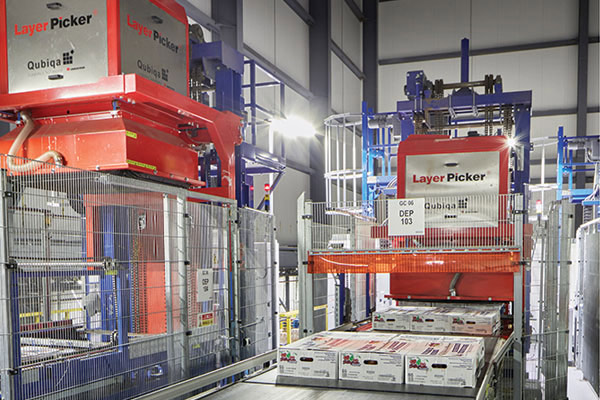Refrigerated & Frozen Food to Your Table
From aging facilities to a lack of warehouse labor, cold storage is challenged. Fortunately, several forces from new capacity and consolidation to a surge of automation promise to make order fulfillment of refrigerated and frozen food more efficient than ever.
Realize it or not, but you have a cold storage problem. And you are responsible.
Yes, there actually is too little refrigerated and frozen food storage capacity right now.
No, none of this has anything to do with the Covid-induced supply chain shortages we’re all experiencing.
Instead, our habits are changing. We are simply buying more refrigerated and frozen foods than even two years ago. Just take a minute and go look in your home fridge and freezer. Surprised by what you see? In fact, typically 9% to 12% of your grocery basket requires cold storage, explains Colman Roche, vice president of sales and consulting, e-commerce/retail at Swisslog Americas.
Companies from Americold to Walmart and your local grocer in between are simply short capacity. But a huge effort is underway to alleviate that problem. Don’t worry, you will not be denied the latest oat milk or frozen red, white and blue parfait.
Several forces in play
Just to give you an idea of how strong growth is in this space, the American Frozen Food Institute says this segment of cold storage accounted for more than $65 billion in sales in 2020. That’s a 21% increase in dollars and 13% increase in units from the year before. The largest growth was in the top three frozen food categories: seafood (35%), poultry (35%) and appetizers (29%).
Online buying is part of that same trend. Online frozen food sales saw an increase of 75% from 2019. That was primarily concentrated in frozen dinners/entrees, meat, poultry and seafood.
Matt Rivenbark, director of sales for food and beverage at SSI Schaefer, sums up demand in one word: Outrageous.
Recently, Walmart pushed forward by building what it calls its “first high-tech distribution center for fresh and frozen groceries…This innovative DC in Shafter, Calif., will use Witron’s technology to process grocery perishables—produce, eggs, dairy, flowers and frozen goods.” And it will, says Elizabeth Walker at Walmart corporate affairs, “move 40% more product than a traditional DC—and result in fewer crushed strawberries.”
Key technologies here, explains Norman Leonhardt, director of business development at Witron, includes automated storage and retrieval systems (AS/RS), conveyors and automated palletizers.

“Every product is measured and documented so that we know how to handle it,” explains Shayne Wahlmeier, one of the Walmart engineers on the project. “A computer algorithm shows all the cases ordered for a given store and determines how to palletize them to maximize the space on a pallet or trailer. It also takes into account density—what’s crushable, what’s not,” he adds.
Meanwhile, Americold is building two temperature-controlled warehouses. The Dematic integrated solution features goods-in receiving, automatic pallet building and de-layering, tray handling sortation and ergonomic case pick along with a high-bay unit-load AS/RS.
Automation is often the mantra in cold storage, explains Tom Swovick, market development manager for food and beverage at Dematic. Or as Leonhardt says, “two years ago people didn’t want to talk about automation, but they do now. The perception of automation has changed.”
To begin, there’s the matter of labor shortages and the lack of interest in working at temperatures of 40°F to -15°F. “Even a 20% to 50% pay premium is often insufficient incentive,” adds Leonhardt.
It’s worth noting that the average age of U.S. cold storage facilities is also at a crossroads. Grant Beringer, vice president of consumer goods west at Swisslog Americas, estimates that nearly 80% of existing facilities are at least 20 years old. This creates its own vortex of powerful forces.

As Swovick points out, many existing facilities are sufficiently old that their cooling system efficiencies are inadequate. Meanwhile, pressure is increasing to decrease the carbon footprint of these facilities. That often leads to the decision to build a new warehouse and “makes automation the obvious solution in cold chain,” adds Swovick.
At the same time, “consolidation continues to play a major role in the growth of the largest players in the cold storage industry,” says Matthew Ott, president and CEO of the International Association of Refrigerated Warehouses (IARW). Its members currently own and operate 6.3 billion cubic feet of capacity.
Americold, for instance, is in the process of buying the world’s fourth-largest, temperature-controlled warehouse, Argo Merchants Group, for nearly $1.8 billion. Lineage has recently completed multiple acquisitions from Seattle to Iowa, Wisconsin and Virginia. The list of other acquisitions among third-party logistics providers in cold storage goes on. The experts say no end is in sight.
Automation takes control
When asked what’s dominating cold storage today, Brad Moore, vice president of business development at viastore Systems, says “automation, automation, automation. I don’t need to say anything more.”
But he does. And with good reason. Moore points out that the most efficient and economical solution in a cold or frozen warehouse is automation because it enables higher storage density, requires a smaller storage footprint, and makes it easier to keep temperatures constant. Additional benefits include more frequent turnover of goods, easy and transparent monitoring of processes and goods as well as a lower personnel requirement, adds Moore.
Much of that automation is going into greenfield facilities. While some retrofit automation is underway, there are limitations, says Rivenbark of SSI Schaefer. To begin, you can’t understate the limitation of inefficient cooling systems. Also, many older facilities actually sit on concrete slabs that cannot support the weight of a new AS/RS, he explains. Furthermore, 40-foot-tall buildings also limit storage capacity. That combination inherently limits the ultimate efficiency of a pallet storage system upgrade.
But don’t entirely rule out retrofits, says Victor Hoerst, director of systems sales at Stoecklin. Shuttles are key here. These mobile platforms ride with the storage/retrieval machine that delivers them to specific deep lanes where they putaway and retrieve pallet loads, explains Hoerst. He points out that regenerative power capabilities on the shuttles helps to manage power demand and use as the automation runs 24/7.
That said, pallet storage systems do dominate equipment in greenfield DCs these days. By maximizing storage density, they reduce the footprint of the facility and the cubic space that needs to be cooled at considerable expense. That doesn’t mean full pallets out of the facility are standard, however.
The order profiles of refrigerated and frozen shipments continue to change, says Beringer of Swisslog Americas. “The final customer order is increasingly fluid, and that is requiring some shifts in how pallet loads from DCs are being built. And that doesn’t even touch on the advent of online cold storage orders direct from consumers,” he says.

That means that to various degrees, layer, case and piece picking all have their place in automated cold storage, notes Rivenbark. For instance, gantry robots are used to pick single SKU layers and place them on order pallets. The majority of case and piece picking is manual, still, Rivenbark adds.
One place where automation does fit is a robotic case picker from Stoecklin, says Hoerst. The Co-Pro automatically moves cases, crates and cartons directly from pallets to conveyor and other robotic systems, eliminating labor. Hoerst says that it’s a scalable solution for new and existing facilities.
Despite the strength of the drive to automation, manual handling in cold storage remains broad, explains Gijo George, director of major accounts for food processing and distribution at Yale. “It’s critical that the lift truck operator remain comfortable and effective. There is great emphasis placed on maximizing the driver’s productivity for a full shift,” he adds. To that end, heated ergonomic features range from controls to cab protection.
About your online order
We’re all sufficiently obsessed these days about our online orders. Most of the time we’re focused on e-commerce from large DCs, even when it comes to refrigerated and frozen items. But that scenario is changing rapidly, explains Roche of Swisslog Americas.
Better yet, it comes with a new acronym—MFCs. Yes, as in micro-fulfillment centers.
MFCs are very much in the getting-to-know-you phase. As Roche explains, when a typical grocery store’s volume approaches 10% from online orders, personal shoppers start to clog up the aisles. When online orders get to 15%, watch out.
An MFC is an onsite order fulfillment center in the back of the store dedicated to those online orders. It takes order fulfillment people off the floor, but requires an entirely new and parallel order management process from equipment to picking items. To make it even more complicated, a typical order profile is literally being created from scratch for MFCs. There isn’t any data to work from.
Just as challenging, MFCs are small and typically hold only 2.5 to 5 days of inventory. And remember Roche was the guy at the beginning of this article who said refrigerated and frozen items account for 9% to 12% of all grocery orders. That doesn’t change just because an MFC is involved.
As Roche explains, grocers are very much in the pilot stage. But early indications are that automation will figure prominently here, and no less so for cold storage items. You may not have seen your first MFC yet, but the genre certainly will command the attention of the cold storage world going forward.
Going forward is clearly the recurring theme for refrigerated and frozen food handling. Probably few other areas in order fulfillment have as much change underway at once. But don’t despair, that mid-summer parfait will make it to your home freezer—and probably faster than ever before.













